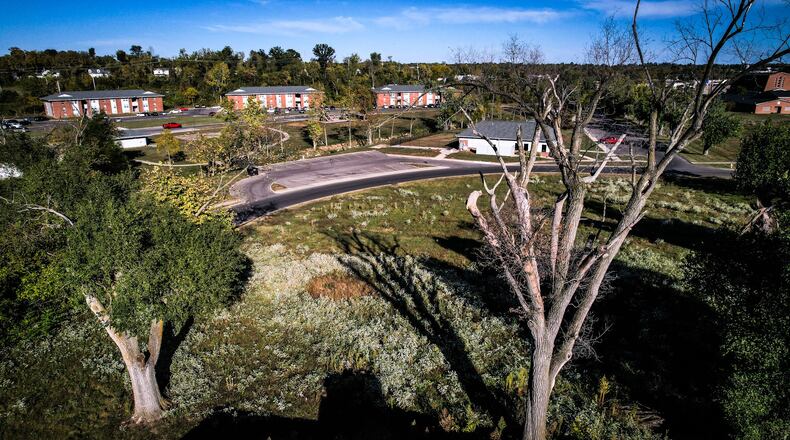Higgins is among countless amateur arborists in the Dayton region in a tree transition, those replacing or removing the “green infrastructure” for a variety of reasons.
In addition to neighborhoods denuded by the 2019 Memorial Day tornadoes, experts say residential development decades ago is contributing to the demise of trees in some areas. In response, local governments and agencies are trying to restore tree cover across the region because of the myriad practical benefits provided by trees.
Many communities require property owners to extract dead, dying and hazardous trees or face penalties. Removals can cost up to $5,000 or more and sometimes take months due to business backlogs, officials said.
Some property owners seeking to replant — like those who lost trees in the Memorial Day tornado outbreak in 2019 — were part of life-altering damage that occurred overnight.
Along with hundreds of homes damaged across Beavercreek, Brookville, Dayton, Riverside and Trotwood and other communities in the path of the storm, at least 1,000 trees were destroyed in a span of fewer than three hours.
Unlike housing, “you can’t just rebuild an 80-year-old oak tree,” said Grady McGahan, director of RETREET, a Texas-based nonprofit working to replace trees in tornado-damaged areas.
“It’s going to take decades for that to be seen and felt the way that it was when the loss occurred,” he added.
Mortality rates
In many Centerville cases, more trees are aging out and dying, ending a life cycling that began with suburban expansion and residential tree growth in the 1960s and ’70s, said Sande Heck, city code enforcement officer.
“It’s getting worse,” he said.
“Some of them got too big or they got old. Some of them have a lifespan and they die” through diseases like emerald ash borer and others, Heck said. “It seems to be many more than it used to be.”
Many trees planted on city of Kettering land in the past five to seven years replaced those lost to emerald ash borer, said city parks Superintendent Gary Schussler, a certified arborist.
Credit: JIM NOELKER
Credit: JIM NOELKER
But Kettering is seeing a different issue than Centerville, he said.
“It’s not from the perspective that all of these trees are in decline because they were planted 50 or 60 years ago,” Schussler said. “It’s ‘let’s understand what our mortality rate looks like’ and then identify what is a feasible number of trees that we can plant and maintain on an annual basis.”
Part of the reason trees are dying, another certified arborist said, is the development surrounding them.
Trees that die 20 or 30 years after a subdivision is built can be directly linked to construction damage, said Mark Webber, who operates a Dayton landscaping business.
Forest tree roots of the same species are often grafted to improve stability and nutrient intake, he said. Those roots need protection to avoid decaying from the ground up, shortening their lifespan, Webber said.
Higgins said he is planting trees closer together so the roots can intertwine and be more stable.
Cities giving away trees
Some communities are addressing aging and dying trees through replacement efforts and increasing maintenance.
Beavercreek and Beavercreek Twp. gave away more than 450 trees last year to city and township residents affected by the 2019 tornadoes.
Beavercreek also applied for a grant for tornado-related projects and plans to purchase 40 trees. Centerville removed 15 trees last year on city-owned property, planted 29 and pruned more than 700 trees, said Marty Tackett, city public works supervisor.
Kettering’s maintenance of the nearly 8,000 trees on city land is outlined in an 86-page urban forest management plan completed in 2020.
It gives “us guidance and direction on how to go about maintaining trees … the type of trees that we select, the number of trees we try to plant each year based on mortality rates that we have throughout the system,” Schussler said, adding that involves a risk assessment.
“The first and foremost thing that we do is identify native trees as much as possible when we’re selecting trees to plant,” he said. “But the tree risk assessment identified issues with certain trees that we needed to address.”
Tree benefits
Trees provide a variety of benefits, industry professionals said. They have been shown to improve both the physical and mental health of people who spend time in nature, Webber said.
Further, Webber and McGahan said, they provide habitat and food sources for wildlife; provide heating and cooling benefits to homes and schools, helping to lower energy bills; and serve to prevent stormwater runoff, flooding and soil erosion.
“They’re huge pieces of green infrastructure,” McGahan said. “The amount of rainwater that a tree can keep from hitting the ground … is way more gallons than you imagine it to be.”
An inch of rain in an acre of forest will produce about 750 gallons of stormwater runoff, Webber said. That same amount of rain on an acre of asphalt produces 28,500 gallons of stormwater, he said.
The Johnny Appleseed Street program in Oakwood provides residents with trees grown in a local nursery, said Carol Collins, the city’s leisure services director.
Oakwood pays half the cost if the trees are planted between the curb and sidewalk. The 43-year-old fall program has accounted for more than 3,200 trees in the city, Collins said.
“Tree are very important because they do offer a lot of value to the properties that we have, as well as the environment,” she said. “We’ve always felt that it’s an important part of the ambiance of the community.”
Collins estimated that city-owned property has nearly 9,000 trees with a combined value of $18 million. Some trees in the city are believed to be 80 to 100 years old, she said.
“We try to maintain (trees) the best we possible can,” Collins said. “But we also understand, too, that the homeowner also has some responsibility there as well.”
Removal violations
Many communities require hazardous trees to be removed. Violating property owners in Beavercreek, Centerville, Kettering, Miamisburg, Washington Twp. and Xenia face assessments, fees, fines or court cases, according to results of a Dayton Daily News survey.
Since 2019, those six communities have recorded more than 1,450 violations, 600 of which were filed in Xenia, survey results show.
Centerville violators could face a fourth-degree misdemeanor while Kettering offenders who fail to reimburse the city for removal will find the bill on future real estate tax assessments, records show.
“We concentrate on trees overhanging sidewalks or streets,” Centerville’s Heck stated.
Beavercreek has a similar process to Kettering, according to Zach Wike, assistant parks superintendent.
“For trees in the right-of-way, the city removes approximately 20 to 30 trees annually,” Wike said in the survey response. “This number has decreased over the last several years as most of the ash trees that have died from the emerald ash borer have been removed.”
While the ash borer impact still lingers, other tree species pose concerns, officials said. Although decorative, Bradford pears — also known as Callery pears or sometimes Cleveland select — are among them. An invasive species, they will be banned from being sold or planted in Ohio starting in January.
Callery pears haven’t been part of Oakwood’s program since the 1990s, Collins said. “There was concern about their branching habit and being weak wooded,” she said.
Infestation of certain trees has magnified the need for a variety of types being planted, Kettering’s Schussler said.
“When you have a monoculture of trees, it impacts you much larger,” he said. “So, we try to keep our diversity … If we do deal with an infestation of some kind, it’s not taking all the trees at once.”
Tornado recovery
Replacing at least 1,000 trees in 2019 tornado-ravaged communities is the goal of McGahan’s organization.
“There were way more than 1,000 trees lost. I have no doubt about that,” he said.
RETREET is working with the Miami Valley Regional Planning Commission, the Dayton Foundation and other groups as part of the Miami Valley TREEcovery Campaign.
More than 5,700 properties were damage across 15 communities in Miami, Montgomery and Greene counties from the outbreak, MVPRC records show.
“It is reasonable to assume where properties were damaged, so were trees,” Laura Henry of the commission said in an email.
The goal is to re-establish the trees that once provided shade, energy savings, and other benefits to residents and wildlife across a large swath of the region impacted by the storm.
Native trees six to nine feet tall are being planted, according to the MVRPC’s website. Property owners who sustained damage can request up to two trees at www.retreet.org/mvtc. Property owners making requests can also ask for tree debris be removed.
The project has had more than 300 requests. The goal is to have all plantings done by April 2023, McGahan said.
TREE CODES
Many communities have property maintenance codes for trees on private property. Those responding to a Dayton Daily News survey include the following:
Jurisdiction 2019-22 violations Penalties
Beavercreek 103* City removal cost or assessment
Centerville 332 City removal cost or court charge
Kettering 436 City removal cost or assessment
Miamisburg 6 Court charge
Washington Twp. 88 Court charge
Xenia 600 City removal cost, $150 fee
*Includes average number of trees city removes annually from right of way and those ordered to be removed from private property.
Sources: Beavercreek, Centerville, Kettering, Miamisburg, Washington Twp. and Xenia.




